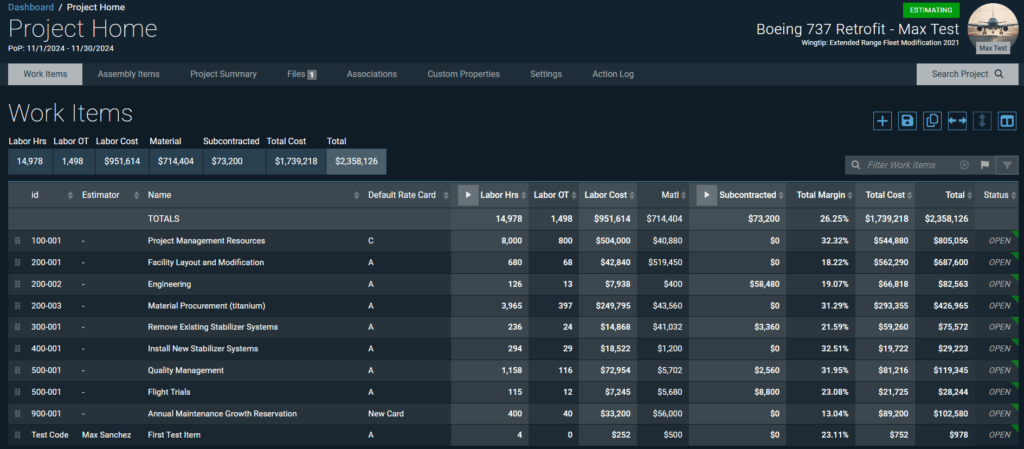Organizations seeking to win large-scale government and commercial contracts face unprecedented challenges in cost estimation and proposal development. Traditional on-premise estimation tools simply cannot match the speed, accuracy, and collaborative power needed to compete effectively. This is why forward-thinking companies are embracing cloud-based cost estimation software like OAE to streamline their bidding processes and secure more contracts.

The Strategic Advantages of Cloud-Based Cost Estimation
Real-Time Collaboration and Multi-User Access
Cloud-based estimation platforms eliminate the bottlenecks of traditional estimation workflows. With OAE’s multi-user interface, internal teams and external contractors can work together seamlessly in real-time. This collaborative approach enables instant communication, simultaneous document editing, and immediate feedback cycles that are impossible with desktop-based solutions.
Unmatched Scalability and Flexibility
Cloud scalability offers organizations the ability to dynamically adjust resources based on demand without significant infrastructure investments. During peak bidding seasons or when pursuing large government solicitations, teams can instantly scale their estimation capabilities without purchasing additional hardware
Significant Cost Savings and Operational Efficiency
The financial advantages of cloud-based estimation are substantial. Organizations benefit from predictable budgeting models, automatic software updates, and 24/7 monitoring by IT experts, capabilities that would be prohibitively expensive to duplicate internally
Overcoming Traditional Estimation Challenges
Excel Limitations and Manual Process Inefficiencies:
Many organizations still rely on Excel or basic software tools that create significant operational bottlenecks. These legacy approaches suffer from manual data entry errors, a lack of real-time collaboration, poor data aggregation, and rigid structures that cannot accommodate complex variable-based projects like Engineer-to-Order (ETO) work.
Traditional manual calculations are time-consuming and error-prone, limiting the number of bids organizations can submit each season. OAE eliminates these constraints by automating calculations, integrating with digital blueprints, and providing sophisticated built-in features that handle complex estimation scenarios with precision.
Version Control and Data Management Issues
On-premise solutions create significant challenges with version control, especially for addendums and project modifications. Team members working on different versions of documents create confusion, delays, and potentially costly errors in final proposals.
Cloud-based platforms provide a single source of truth for all project data, ensuring everyone works with the most current information. Automatic synchronization eliminates the chaos of scattered spreadsheets and prevents the miscommunications that plague traditional estimation processes.
Limited Accessibility and Mobility Constraints
Traditional desktop-based estimation software restricts teams to office-based work, limiting responsiveness to client needs and market opportunities. Field teams cannot access or update critical information in real-time, creating delays and reducing competitive advantage.
Cloud-based solutions enable access from anywhere with an internet connection, using any device, desktops, tablets, or smartphones. This mobility allows teams to respond to RFPs faster, make real-time adjustments during client meetings, and maintain productivity regardless of location.
How Modern Estimation Apps Can Streamline Your Proposal Process
Cloud-based platforms dramatically reduce the time required to develop comprehensive proposals. Teams can leverage historical data, reuse proven calculators, and build upon past successful bids to accelerate the estimation process. The ability to copy work items, schedules, labor breakdowns, and other estimate components from previous projects provides significant time savings while maintaining accuracy. This efficiency translates to the ability to pursue more opportunities and submit higher-quality proposals within tight deadlines.
One of OAE’s most powerful features is its ability to capture decades of estimating experience and convert it into reusable organizational knowledge. This knowledge retention capability ensures that critical expertise remains available even as team members change, creating sustainable competitive advantages. The platform enables organizations to build libraries of best practice bids, standardize estimation approaches, and continuously improve their bidding processes based on historical performance data.
As the industry continues evolving toward digital transformation, organizations that embrace cloud-based estimation solutions will be best positioned to capture larger contracts, improve operational efficiency, and build long-term market leadership. The question is not whether to make this transition, but how quickly organizations can leverage these powerful capabilities to outpace their competition.

